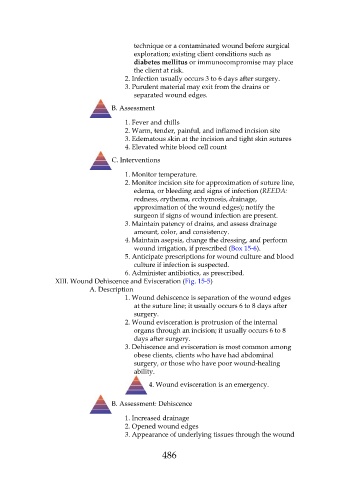Page 486 - Saunders Comprehensive Review For NCLEX-RN
P. 486
technique or a contaminated wound before surgical
exploration; existing client conditions such as
diabetes mellitus or immunocompromise may place
the client at risk.
2. Infection usually occurs 3 to 6 days after surgery.
3. Purulent material may exit from the drains or
separated wound edges.
B. Assessment
1. Fever and chills
2. Warm, tender, painful, and inflamed incision site
3. Edematous skin at the incision and tight skin sutures
4. Elevated white blood cell count
C. Interventions
1. Monitor temperature.
2. Monitor incision site for approximation of suture line,
edema, or bleeding and signs of infection (REEDA:
redness, erythema, ecchymosis, drainage,
approximation of the wound edges); notify the
surgeon if signs of wound infection are present.
3. Maintain patency of drains, and assess drainage
amount, color, and consistency.
4. Maintain asepsis, change the dressing, and perform
wound irrigation, if prescribed (Box 15-6).
5. Anticipate prescriptions for wound culture and blood
culture if infection is suspected.
6. Administer antibiotics, as prescribed.
XIII. Wound Dehiscence and Evisceration (Fig. 15-5)
A. Description
1. Wound dehiscence is separation of the wound edges
at the suture line; it usually occurs 6 to 8 days after
surgery.
2. Wound evisceration is protrusion of the internal
organs through an incision; it usually occurs 6 to 8
days after surgery.
3. Dehiscence and evisceration is most common among
obese clients, clients who have had abdominal
surgery, or those who have poor wound-healing
ability.
4. Wound evisceration is an emergency.
B. Assessment: Dehiscence
1. Increased drainage
2. Opened wound edges
3. Appearance of underlying tissues through the wound
486

